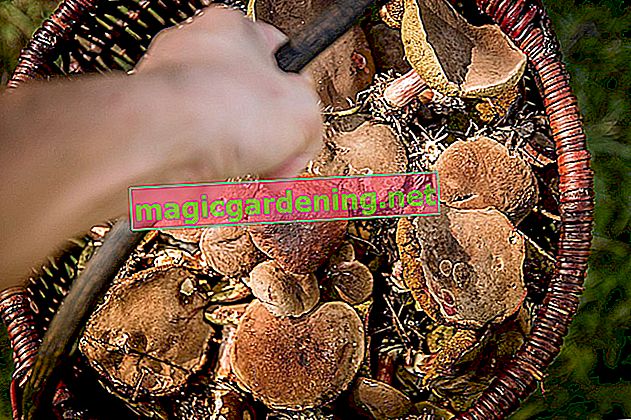
Plant willow properly
Plant a wild willow in normal garden soil in a sunny spot. You offer the decorative ornamental shrub the best starting conditions with a planting time in autumn. Thoroughly loosen the soil to remove weeds, roots and stones. Then dig a planting pit with 1.5 times the volume of the root ball. Mix the excavated earth with compost and horn shavings, the kitten pasture feels particularly welcome in its place. Position the potted root ball in the pit so that it ends flush with the surface of the earth. The cavities are filled with the enriched substrate, trodden down and poured on in large quantities. A mulch layer of leaves or bark mulch rounds off the skillful planting process.
also read
- The early blooming season of the willow is good for the bees
- Sallow willow is well suited for planting hedges
- Leaves of the common willow
Care tips
The clear care program makes it clear why the wild willow can act as a pioneer plant in the wild. The only thing that matters is these measures:
- Watering in summer drought
- Apply a slow release fertilizer in April and July
- Apply liquid fertilizer in the bucket from March to August every 30 days
- Light winter protection is only advisable for potted plants
Immediately after flowering, cut the vigorous kitten willow into shape and thin out the wood.
Which location is suitable?
The location should be as sunny as possible so that the tightly upright or decoratively overhanging branches present themselves in their lush kitten splendor. The common willow also tolerates light shade. If, however, the daily solar output drops below 4 hours, look in vain for the furry spring bloom. With regard to the soil quality, the palm willow accepts almost all local conditions, as long as there is no waterlogging dominated there.
What is the best time to plant?
As long as the ground is not frozen, plant the common willow in a sunny to partially shaded spot. In the best case scenario, choose between September and November as the planting time. The young roots spread rapidly in the sun-warm soil, so that the ornamental shrub starts its first gardening season with a vital growth lead.
When is the flowering time?
The pure species delights us from March to April with silvery fur blossoms that gradually turn golden-yellow. The Advent willow is an exception - also known as Silberglanz. The ornamental wood allows the silver-white fur kittens to sprout as early as December and lasts until March.
Continue reading
Cut willow properly
The vehement growth of up to 100 cm per year goes hand in hand with a first-class cut tolerance. Cut back the willow immediately after flowering. This pruning can easily remove up to two thirds of the shoots. Hanging kitten willows can even tolerate a cut of up to 10 cm. Of course, the pioneer wood reacts to this with an extra strong shoot. As part of the cut, the wood is carefully thinned by cutting off all dead wood close to the ground or on astring.
Continue reading
Water willow
A Sal willow is satisfied with the natural rainfall. There is only a need for watering during summer drought, because the root ball should not dry out completely. In contrast, in bucket culture, the soil dries out quickly in a sunny location. So check every few days with a thumb test whether the substrate has dried 3-5 cm deep. Put the water directly on the root disc.
Fertilize willow properly
If you fertilize a kitten pasture in April and July with a mineral-organic slow-release fertilizer, the nutritional requirements are optimally covered. Alternatively, you can work ripe compost on the surface of the root disc every 4 weeks and then pour it extensively. Since supplies run out quickly in the tightly limited substrate volume of the bucket, apply a liquid fertilizer every 30 days from March to August.
Overwinter
As a native wood, the Sal willow is ideally suited to the local winter. So no special precautions need to be taken, especially since all leaves are shed. If the kitten pasture in the bucket is in a location exposed to the wind, wrap the container in foil or jute as a precaution and slide a block of wood underneath.
Propagate willow
You can easily grow additional willow trees with the help of cuttings. If the wood is full of sap, cut semi-lignified head cuttings that are not in bloom. These are defoliated in the lower half and placed in pots with a poor substrate. In the partially shaded location, with a regular water supply, the rooting progresses rapidly. Plant out the young kitten willows in autumn. Propagation by means of unleaf cuttings takes place in a similar way during winter so that they can be planted in the bed in spring. Unlike a cutting, you cut a cuttings from the center of the branch.
Continue reading
Common willow in a pot
The small hanging kitten willow sets eye-catching accents in the bucket on the balcony and terrace. The vessel should have a volume of at least 40 liters. Any common potting soil can be used as a substrate, ideally enriched with a little sand or perlite. (€ 32.90 at Amazon *) In contrast to other species in the field, a wild willow in the pot is watered regularly. You can also pamper the ornamental wood with a liquid fertilizer every 30 days from March to August. Before the first frost, the bucket is given a winter coat made of jute ribbons, foil or garden fleece. Water every now and then during the winter to keep the soil from drying out. The graceful type of willow is cut immediately after flowering.
Trivia
The Sal willow has a firm place in the customs to this day. On Maundy Thursday the flowering branches are cut in order to decorate them in the vase with colored eggs for Easter. On Palm Sunday, the green leafy branches are a central part of the sticks decorated with colorful ribbons that children carry to the procession. Small tufts of palm branches are attached to the crucifix to keep harm away from the house and yard.
Nice varieties
- Mas: A purely male Sal willow that sets itself apart with large, yellow catkins and a wonderful scent; 5-8 m
- Pendula: Distinctive willow catkins with clearly overhanging branches; a perfect solitaire; 4-6 m
- Kilmarnock: Small willow tree with arching branches; ideal as a small tree for the front yard; 1-2 m
- Silver luster: Very early flowering variety that bears catkins as early as December in mild winters; 4-6 m
- Bögelsack: fast-growing variety that bears golden-yellow catkins from March; wonderful autumn colors; 4-8 m








